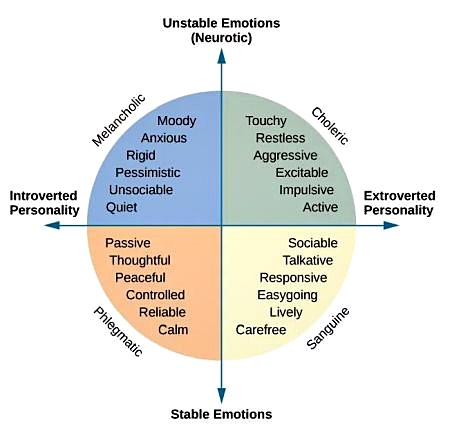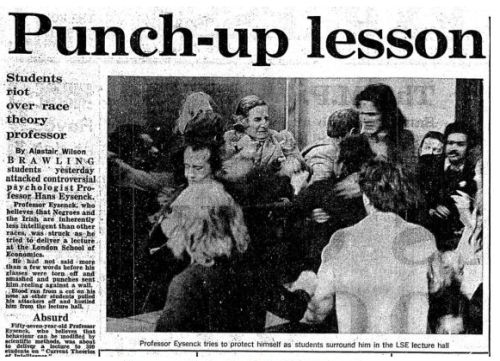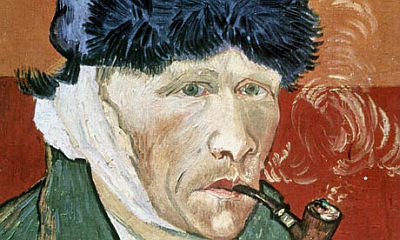
|
Home DH-Debate 3. Cattell 16PF Scales 5. Rorschach's Inkblot Test |
| 1. Introduction | 2. Inborn Traits |
| 3. Three Personality Scales | 4. Extraversion |
| 5. Neuroticism | 6. Psychoticism |
| 7. Creativity | 8. Typical Questions |
| 9. Litteratur |
Hans Eysenck was born in Germany in 1916. He was the son of a nightclub-entertainer named Anton Eysenck and a famous actress named Helga Molander. His parents were both Christians. He grew up with his grandmother, who was an ardent Protestant Christian.

Hans Eysenck 1916-1997.
Due to persecution of Jews, he fled to England at the age of 18 years. He was - as mentioned - not himself a Jew, but felt sympathy with the Jews. He wrote in his autobiography: "My hatred of Hitler and the Nazis, and all they stood for, was so overwhelming that no argument could counter it."
In England he became a famous psychiatrist. He got his Ph.D. in psychology from the University of London in 1940. During World War II, he worked as a psychologist at an emergency hospital, where he also researched the reliability of psychiatric diagnoses. He became Professor of Psychology at the Institute of Psychiatry, King's College London in 1955, a position he held until 1983.
Until his death in 1997, he wrote 80 books and perhaps more than 1,600 scientific articles. In the book "Decline and Fall of the Freudian Empire" he criticized Sigmund Freud.
In another book, "Race, Intelligence and Education", Eysenck supported American psychologist Arthur Jensen's theory that intelligence is hereditary and that the difference between black and white Americans' IQ test results was caused by genetic differences that could not be offset by teaching.
It was precisely in these years that Africans and Indians from across the collapsed empire flooded into Britain. His theory of hereditary personal characteristics was therefore highly controversial. Eysenck experienced being assaulted by revolutionary students in connection with a lecture at the London School of Economics. He also received bomb threats and threats that political opponents would kill his young children.

Professor Arthur Jensen during a lecture at Berkerly University in California in 1970.
Hans Eysenck designed most of his personality tests with his son, Michael Eysenck, who also became a psychologist.
His theory of personality is primarily based on physiology and genetics. Although he placed great emphasis on learned traits, he considered basicly personality to be part of the genetic heritage. Thus, according to Eysenck, one must expect that lively, outgoing parents will tend to have lively and outgoing children, aggressive and dominant parents will tend to have aggressive and dominant children and intelligent parents will tend to have intelligent children.
The classical four temperaments are precisely characterized by that they are determined by physical, bodily, conditions, namely different body fluids, and therefore physiologically and genetically determined. They were thus an obvious starting point for Eysenck.

|
The four temperaments on drawing from the 17th century:
- The choleric temperament is determined by the body fluid, yellow bile. A choleric person is outgoing, restless, impulsive, optimistic and dominant. He is very concerned with his own needs. The choleric is easily aroused.
- The sanguine temperament is determined by the body fluid, blood. The sangviniker is very lively and outgoing. He is very concerned about his own needs, but is careless and does not take things very serious.
- The melancholy temperament is determined by the body fluid, black bile. A melancholic is introverted, melancholy, silent, slow and thoughtful. He is not concerned with his own needs, but with those of others. He rarely gets really angry.
- The phlegmatic temperament is determined by the body's lymph or slime. The phlegmatic is also slow and thoughtful, but at the same time stubborn, skeptical and preoccupied with his own needs. He rarely shows anger.
Drawing by Charles Le Brun from the 1600's. RMN Wikipedia.
Eysenck studied infants' behavior and demonstrated - as most parents already know - that from birth there are clear differences from child to child in terms of, for example, well-being, irritability, pace and energy, sociability, impulsivity, anxiety, tendency to cry. and much more. Which clearly indicates that personality is largely innate.

Eysenck's two original personality scales in a x-y plane adapted to the classical temperaments: The X-axis "Extraversion / Introversion" (E) and the Y-axis "Neuroticism / Emotional Stability" (N).
Eysenck noted how these two dimensions describe the four classical personality types introduced by the ancient Greek physician Hippocrates who lived four thousand years ago.
Later in his career, Eysenck added a third scale namely "Psychoticism / Normal Socialization", which can not well be displayed graphically in an x-y plane along with the first two scales.
High N and high E = choleric type
High N and Low E = Melancholic type
Low N and High E = Sanguine type
Low N and Low E = Phlegmatic type
Photo Psynso.
When a large part of personality is innate, one should by first hand think that then these qualities and tendencies, which represent the personality, are also immutable during the life of the individual.
However, the controversy - over whether personality tests are relevant or not - is precisely that some believe that our personality and thus habits and behavior are not immutable, but that we can consciously adapt to the ever-changing challenges of reality that we face in the course of our lives. In this case, a test would simply put the individual in a box.
An introverted manager or an introverted teacher can develop habits and routines that make him visible to his staff and students, even though he may feel it is exhausting. An anxious leader can learn to harden himself and make the necessary decisions under uncertainty, and likewise become accustomed to taking any setbacks as a man, though he will probably find it strenuous in the long run.

Eysenck tries to protect himself during an attack by members of a Maoist student group in connection with a lecture at University May 8, 1973. The Daily Telegraph reported: "Before Prof. Eysenck had a chance to begin, he was met with shouts, whistles, and obscenities. About 15 students from the front two rows jumped across the table and started beating with their fists. They struck in all directions." The newspaper further reported that Eysenck had "his glasses destroyed, a wound in his nose and was pulled in his hair". Photo Daily Telegraph.
One can get used to the necessity of being visible at all times - to promote and exercise a natural authority - for example as a politician, leader, teacher or officer, even if such behavior is not from the beginning particularly natural or pleasurable. One can learn to analyze a problem in an intellectual and systematic way, even if one is only normal well gifted and not born overly intelligent.
Author Annie Murphy Paul is very critical of personality tests. She writes that personality tests put individuals in a box, even though they are quite capable of changing and adapting to changing circumstances. However, she admits that a few personality traits are really innate and relatively unchangeable throughout our lives, such as "introversion / extraversion" and "level of aggression" as the latter is a well-known function of various innate hormones. She should have included "intelligence", as it is well known that intelligent parents have a tendency to have intelligent children.
But everything else, she writes, including most of Cattel's 16 personality traits and Big Five's 20 subscales, may well be too complex and changeable to be measured in an objective and meaningful way.
Eysenck's three main scales "Extraversion / Introversion", "Neuroticism / Emotional Stability" and "Psychoticism / Socialization" describe precisely such very basic - presumably innate - personality traits that we can believe are genetically determined and thus unchangeable during a person's life.

Hans Eysenck speaks to the Daily Mail on May 10, 1973 about the assault. Photo Daily Mail.
One cannot accuse Eysenck of following the popular moods. His theory of hereditary personal traits is in all probability true, but it was not popular in his days. It was precisely in his time that Enoch Powell's political career was destroyed because of his "Rivers of Blood" speech. Africans and Indians from across the collapsed empire flocked to Britain. But that did not stop him from writing in his book, "Race, Intelligence and Education" in 1971: "All the evidence to date suggests it - the overwhelming importance of genetic factors to produce the vast array of intellectual differences that we observes in our culture, and much of the difference observed between certain racial groups."
In his 1973 book, "Inequality of Man", he wrote that "The entire developmental course of a child's intellectual capacities is largely genetically determined, and even extreme environmental changes - have little power to change this development."
Eysenck originally introduced two overall personality scales namely "Extraversion/Introversion" and "Neuroticism / Emotional Stability". Later in his career, in 1976, he introduced an additional scale, which he called "Psychoticism / Normal Socialization".
Extraversion/ Introversion |
Neuroticism/ Emotionel Stability |
Psychoticism/ Normal Socialization |
|---|---|---|
|
Sociable
|
Anxious
|
Aggressive
|
|
Irresponsible
|
Depressed
|
Assertive
|
|
Dominant
|
Guilt Feelings
|
Egocentric
|
|
Lack of reflection
|
Low self-esteem
|
Unsympathetic
|
|
Sensation-seeking
|
Tense
|
Manipulative
|
|
Impulsive
|
Moody
|
Achievement-oriented
|
|
Risk-taking
|
Hypochondriac
|
Dogmatic
|
|
Expressive
|
Lack of autonomy
|
Masculine
|
|
Active
|
Obsessive
|
Tough-minded
|
The 27 characteristics listed in these three columns, such as sociable, irresponsible, anxious and so on, all signify high scoring on Extraversion, Neuroticism and Psychoticism respectively. If you are not sociable, but unsociable, if you are not assertive, but less assertive, if you are not egocentric, but empatic and so on, you will score at the low end of the same continuous scales.
Eysenck believed that extraverted people have a kind of innate blackout or repression function in the brain.
If for example, they have had a car accident, they typically do not remember anything afterwards. Precisely because they remember nothing, they will not hesitate to place themselves behind a steering wheel the day after, they have been discharged from hospital.

Introverted type of personality.
If they have had a bad social experience, let's say they have been humiliated in front of a big audience at a party, or they have been rejected by a woman, they love, then their brain's effective repression function makes them quickly forget the bad experiences. Precisely because they have eradicated their bad memories, they will not hesitate to promote themselves at the next big party or introduce themselves to the next women, with whom they fall in love.
This black-out function can, of course, be more or less effective for different people.
Very introverted people have no black-out function at all. They remember with painful accuracy and in all details, how the vehicle skidded, the windshield splintered, screams and blood everywhere. Therefore, they may choose not to drive a car long after they have been discharged from a hospital.
An introverted person will remember in details, how the whole party laughed heartily when he could not remember the text of a song and also probably sang out of tune. For the rest of his life, he will remember the impulsive, condescending laughter, his very special one made, when he asked her to marry. Because he so detailed remembers his bad social experiences, he will gradually take less and less social initiatives.
That people score high on Neuroticism in Eysenck's sense does not mean that they actually have a neurosis. It simply means that tend to experience higher levels of stress and anxiety and thus are more likely to incur an actual neurosis.
Neuroses can be characterized by sudden attacks of anxiety followed by palpitations, dizziness, shortness of breath or the like, possibly triggered by fear of open spaces, narrow spaces, spiders, large crowds, bacteria on the hands and more. But - unlike a psychotic - a neurotic experiences reality as it is, and he knows that he has a small personal problem with the nerves.

Woody Allen and Penelope Cruz. Woody Allen must be said to portray a typically unstable person, that is, a person with a high level of Neuroticism. Eysenck's Neuroticism resembles excessive anxiety.
People who score high on Eysenck's Neuroticism scale worry about relatively insignificant things, and feel unable to cope with the stress of daily life. They tend to focus on the negative sides of a situation rather than the positive ones. They may feel envious of others who they think have come to a more favorable position in an unfair way.
Test takers who score very high on Neuroticism may be more or less compulsive perfectionists. Some psychologists believe that pronounced perfectionism is due to a form of deep-seated inferiority complex.
Eysenck assumes that pronounced neuroticism is biologically conditioned in that such individuals have a low activation threshold in the sympathetic nervous system in dangerous situations. When the sympathetic nervous system is activated, we experience higher heart rate, rapid breathing, high blood pressure, increased blood supply to the muscles, decreased activity in the intestines, increased activity in the brain and more energy.

A couple with high score on Neuroticism. Photo Vivoplay.com
Let us imagine that we have to cross a narrow wooden bridge, let's say one meter wide, without handrails. The bridge leads over an abyss 50 meters deep.
One meter wide is quite convenient, one does not need to be a tightrope dancer to set the foot the right places; only the situation requires a certain concentration. Our brain will receive the signal, that now it may well turn off the dream program and concentrate a bit. Then most will pass the bridge concentrated but stable.
But for some their innate alarm signal to the brain will be so powerful that their entire signal system goes into overdrive. The concentration, which the first alarm signal triggers, will make them look down, and then an even stronger alarm signal will be sent to the brain, and so forth. The person panics.
Eysenck compares the situation with the resonance that occurs when the sound from a speaker is returned to the microphone.
Finally, Eysenck also proposed a third very important personality scale, which he called Psychoticism. It goes from low scoring - a socially well-adjusted personality - to high scoring towards a personality who is prone to psychosis under unfortunate circumstances.
As with neuroticism, a high score on psychoticism does not mean that one is predestined to have such a disorder - just that the test subject has some personality traits that are often found among psychotic patients, and that he or she may be more susceptible to becoming psychotic under critical circumstances.

Person with very high score on Psychoticism. Photo Slideplayer.
Psychotic disorders are those that affect the person's experience of reality. He may hear voices or have an experience of being watched or followed. Unlike a neurotic, he is not necessarily - at least in the first case - aware that he has a problem and what he is experiencing is not real. Typical psychotic disorders are schizophrenia and bipolar disorder, the latter also called manic-depressive.
According to Eysenck, individuals who score high on Psychoticism are prone to engage in irresponsible and careless behavior. They may violate accepted social norms and be prone to criminal behavior. They are motivated by their need for immediate satisfaction, regardless of the consequences.
Eysenck found that patients in hospitals for the mentally ill and criminals had high scoring on his psychoticism scale.
As with the other two main scales of personality, Eysenck found its cause in physiology and genetics. He demonstrated that people with a high psychotic tendency have high levels of the hormone testosterone and low levels of a substance called monoamine oxidase, which affects the levels of neurotransmitters that are important for brain function.
Examples of such Psychoticism tendencies are irresponsibility and recklessness, the downgrading of common sense and inappropriate emotional expressions. Some have found that people with a high score on psychotism also often have a hostile attitude to cultural norms and authorities, they may seem immature and somewhat insensitive and score as well on other hostility scales.
Eysenck is known for his theory that high score on psychoticism is a precondition for creativity.

Self-Portrait by Vincent van Gogh with a bandage on his cut ear.
This idea is often represented in a popular way with the painter Vincent van Gogh, who cut off his ear, and the mathematician John Nash, who developed game theory, differential geometry and partial differential equations, and later came to suffer from paranoid Schizophrenia. Nash has been portraited in the film "A Beautiful Mind".
Artists always have had a tendency to profile themselves as eccentric and a little crazy to make probable that they also are creative.
Eysenck wrote that creative intelligence fundamentally can be characterized as a search process in the brain, which aims to find not generic solutions - during this process different elements from memory are brought together to generate new solutions to problems.
Eysenck believed that there are strong evidences that this search for new solutions is always driven by conscious or unconscious ideas of relevance. Thereby, he disagrees with other psychologists, who believed that the intellectual quest for alternative solutions is a completely chaotic and random process in the brain.

John Forbes Nash, 1928 - 2015. In 1994 he was awarded a shared Nobel Prize in Economic Sciences for his work on game theory.
Socially well-adjusted person will, according to Eysenck, have some rather narrow ideas of relevance; they will instinctively be more conventional and restrictive in their search. Thus they will unconsciously exclude potential solutions that are not socially appropriate. Therefore they will be more limited in their search for potential solutions, and thus less creative.
On the other hand, less socially adjusted persons, who will score quite high on his psychotism scale, will have ideas about relevance, which are much broader and more spacious than the more socially adapted's ideas of relevance. Deep down in their minds, they find cultural norms, authorities and other social contexts less important, and therefore they unconsciously will not let such considerations limit their search for solutions. Therefore persons with a certain level of psykotism will have a tendency to be more creative than very socially adapted people.
Some test persons could be tempted more or less unconsciously to score on psychoticism in order to profile themselves as creative. Perhaps they do not feel so good in exam grades and experience; and therefore they can be attracted to an idea that on the other hand, they may well be creative.
It is not a very good idea. Firstly, most employers are not particularly interested in creativity. They want employees, who are doing, what they are told, and are able to follow procedures and work descriptions. Such as pilots are assumed to follow detailed emergency procedures when they have problems.
Eysenck was probably right that a certain level of psychotism is a prerequisite for creativity, but that does not lead to that you can conclude the reverse; that is, if a person is a little crazy, it will also imply creativity. It is pretty certain that most crazy people are not especially creative.
E scores on "Ekstroversion / Introversion".
N scores on "Neuroticisme / Emotionel Stability".
P scorer on "Psychoticism / Normal Socialisering".
L scorer on "Lie".
Item |
Scoring |
|---|---|
|
Are you rather lively?
|
E
|
|
Do most thing taste the same for you?
|
P
|
|
Are you touchy about some things?
|
N
|
|
Have you ever broken or lost something belonging to someone else?
|
L
|
|
Are you a talktive person?
|
E
|
|
Do you stop to think things over before doing anything?
|
P
|
|
Have people said that you sometimes act too rashly?
|
E
|
|
Have you ever taken advantage of someone?
|
L
|
|
Do people tell you a lot of lies?
|
P
|
|
Do you like doing things in which you have to act quickly?
|
E
|
|
Do you have many different hobbies?
|
E
|
|
Do you often feel "fed up"?
|
N
|
|
Do you worry about your health?
|
N
|
|
Would you like other people to be afraid of you?
|
P
|
|
Are there several people who keep trying to avoid you?
|
P
|
|
Are good manners very important?
|
P
|
|
Do you like telling jokes and funny stories to your friends?
|
E
|
|
If you say you will do something, do you always keep your promise no matter how inconvenient it might be?
|
L
|
|
Do you prefer to go your own way rather than act by the rule?
|
P
|
|
Do you often feel life is very dull?
|
N
|
|
Do you believe one has special duties to one's family?
|
P
|
|
Do you always practice what you preach?
|
L
|
|
Do you have enemies who want to harm you?
|
P
|
|
Do you like going out a lot?
|
E
|
|
Do you often feel lonely?
|
N
|
|
Do you have many friends?
|
E
|
|
Do you often worry about things you should not have done or said?
|
N
|
|
Do you believe insurance planning is a good idea?
|
P
|
|
Do you ever feel "just miserable" for no reason?
|
N
|
|
Do you like to arrive at appointments in plenty of time?
|
P
|
|
Have you ever said anything bad or nasty about anyone?
|
L
|
|
Would being in debt worry you?
|
P
|
Eysenck tests are available under the names "Eysenck Personality Inventory" (EPI) and "Eysenck Personality Questionnaire" (EPQ), both of which may be with or without the Psychoticism scale. They are almost all made by Eysenck & Eysenck, that is, by Hans Eysenck and his son Michael Eysenck.
|
Eysenck Personality Questionnaire Wikipedia Hans Eysenck Wikipedia Eysenck Personlighedstest Similar Minds Eysenck's Personality Inventory Keystones Shodhganga Appendix The Eysenck Personality Inventory TEST Pagine Blu |
| To top |